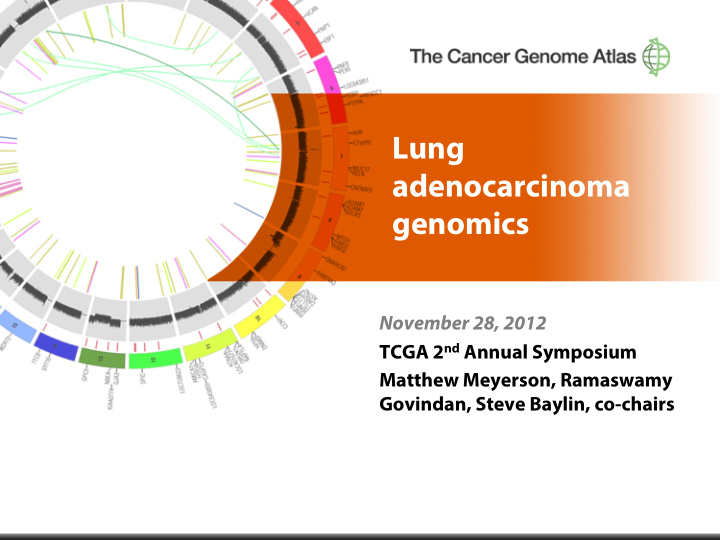



Lung adenocarcinoma genomics November 28, 2012 TCGA 2 nd Annual Symposium Matthew Meyerson, Ramaswamy Govindan, Steve Baylin, co-chairs
Key parHcipants in TCGA ¡lung cancer analysis group Copy number analysis Biospecimen Core DNA methylation analysis Gad Getz, Broad Joe Paulauskis, IGC Leslie Cope, Johns Hopkins Gordon Saksena, Broad Bob Penny, IGC Ludmila Danilova, Johns Hopkins Andy Cherniack, Broad Steve Baylin, Johns Hopkins Project management Kenna Shaw, NCI Clinical contributors Gene expression and transcriptome Laura Dillon, NCI Bill Travis, MSKCC Neil Hayes, North Carolina Margi Sheth, NCI Dennis Wigle, Mayo Clinic Matt Wilkerson, North Carolina Ram Iyer, NCI Gordon Robertson, UBC Cross-platform Analysis Brad Ozenberger, NCI Lauren Byers, MD Anderson Chad Creighton, Baylor Gordon Mills, MD Anderson Tissue collaborators Eric Collisson, UCSF Malcolm Brock, Johns Hopkins Sam Ng, UCSC DNA sequence analysis Ming Tsao, Toronto Jacob Kaufman, Vanderbilt Andrey Sivachenko, Broad Dennis Wigle, Mayo Rileen Sinha, MSKCC Gad Getz, Broad Val Rusch, Memorial Sloan Kettering Ronglai Shen, MSKCC Mike Lawrence, Broad Peter Goldstraw, Royal Brompton Niki Schultz, MSKCC Carrie Sougnez, Broad Kwun Fong, Prince Charles Ron Bose, WUSL Stacey Gabriel, Broad Andrew Godwin, Fox Chase Eric Lander, Broad Maria Raso, MD Anderson Bryan Hernandez, Broad Rajiv Dhir, Pitt Marcin Imielinski, Broad Carl Morrison, Roswell Park Elena Helman, Broad Alice Berger, Broad Working group tri-chairs Mara Rosenberg, Broad Ramaswamy Govindan, Washington U Juliann Chmielecki Dana-Farber/Broad Steve Baylin, Johns Hopkins Angela Hadjipanayis , Harvard Matthew Meyerson, Dana-Farber/Broad Raju Kucherlapati, Harvard 2
Lung cancers account for over 25% of cancer deaths in the U.S. each year Men Women 292,540 269,800 Lung & bronchus 30% 26% Lung & bronchus Prostate 9% 15% Breast Colon & rectum 9% 9% Colon & rectum Pancreas 6% 6% Pancreas Leukemia 4% 5% Ovary Liver & intrahepatic 4% 4% Non-Hodgkin bile duct lymphoma Esophagus 4% 3% Leukemia Urinary bladder 3% 3% Uterine corpus Non-Hodgkin 3% 2% Liver lymphoma 2% Brain/nervous system Kidney & renal pelvis 3% 25% All other sites All other sites 25% 3 Source: American Cancer Society, 2009.
Lung adenocarcinoma ¡is the most ¡ common form ¡of ¡lung ¡cancer ¡ • Lung cancer kills more than 150,000 Americans each year and more than one million people world-wide • Major lung cancer histologies are lung adenocarcinoma, squamous cell lung carcinoma, and small cell lung carcinoma • Lung adenocarcinoma accounts for ~40% of lung cancer diagnoses and ~65,000 deaths each year in the United States. • While lung cancer is generally associated with smoking, lung adenocarcinoma uniquely often occurs in non- smokers 4
Lung adenocarcinoma: ¡paradigm for ¡molecular ¡subtyping ¡ In recent years, treatments for lung adenocarcinoma have shifted from histology-based strategies to molecular-based strategies. We have made major advances in treatment for lung adenocarcinoma with targeted inhibitors of EGFR (gefitinib, erlotinib) and ALK (crizotinib) thanks to genomic discoveries Example: a patient with lung adenocarcinoma, with a somatic EGFR deletion mutant in exon 19 ( thanks to Bruce Johnson, M.D., DFCI) After 2 Before months treatment erlotinib treatment 5
Lung adenocarcinoma: ¡previous ¡ comprehensive ¡genomic ¡studies Weir et al., Nature, 2007: copy number analysis of 371 cases, discovered NKX2-1 and TERT amplifications Ding, Getz et al., Nature, 2008: mutation analysis of 188 cases, discovered mutations of NF1 , ATM , APC Shedden et al., Nat Med, 2008: expression classification of 448 cases Govindan et al., Cell, 2012: whole genome sequencing of 17 cases, identified smoking/non-smoking signatures Imielinski, Berger et al., Cell, 2012: whole exome sequencing of 183 cases, identified mutations of RBM10 , U2AF1 Seo et al., Genome Research, 2012: transcriptome sequencing identified recurrent MET splicing alterations 6
Recommend
More recommend